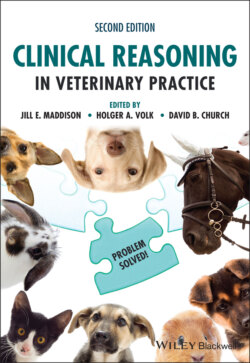Читать книгу Clinical Reasoning in Veterinary Practice - Группа авторов - Страница 44
Time waster or time saver?
ОглавлениеIt is common when first faced with the process of problem‐based inductive clinical reasoning to feel that it is an academic exercise that there simply isn’t time to apply in the context of a busy clinic, 10–15‐minute consultation slots and the many conflicting demands on your time. However, if you are able to put in the hard work initially and if you discipline yourself to think in this way, it will become second nature, subconscious (thus you have reached unconscious competence) and certainly not as laborious as it may appear at the beginning.
In fact, acquisition of these problem‐solving skills will ultimately save time, as it will help you quickly eliminate extraneous background noise and focus on what is important for this patient and client. An analogy is the process of learning a new language. To do so, you initially need to learn some vocabulary and grammar (framework), but once you have a basic understanding and if you use the new language on a daily basis, further progression to fluency aka unconscious competence comes naturally. But without the basic framework and constant practice, fluency is an unfulfilled dream.
Comments from participants in courses based on this approach include:
‘I developed a more systemic approach to medicine, which saved a lot of time in a busy practice’.
‘It made me think more efficiently in a busy practice’.
Hopefully, this will be your experience too. As with all skills, it takes time to develop the knowledge base and mental discipline required for this form of clinical reasoning, but once developed, it will provide a firm base for the future and, most importantly, will not ‘go out of date’, no matter how many new diseases/disorders are discovered.
Figure 2.7 Clinical reasoning step‐by‐step: recap.
